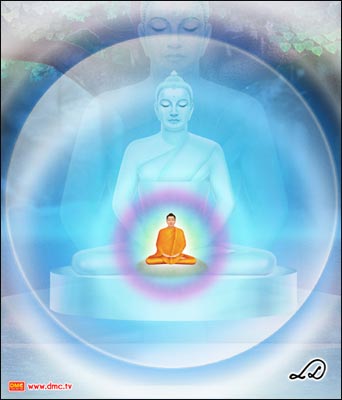The Noble Truth of the Path to the Cessation of Suffering # 3
Even as the meditator attains uccessive inner bodies, he will also see their associated spheres of Dhamma.
7.4 Mindfulness of the dhammas in the dhammas
Mindfulness of the dhammas in the dhammas is to see and consider the mental phenomena both inside and outside, the whole of the time. Seeing the inner mental phenomena is to see the sphere of the Dhamma which is responsible for the arising of the subtle human body. Seeing the outer mental phenomena is to see the sphere of the Dhamma which is responsible for the arising of the sphere of the Dhuman body. With out these spheres of Dhamma, the various bodies could not survive. Even as the meditator attains uccessive inner bodies, he will also see their associated spheres of Dhamma. With each new attainment, the understanding of reality at that level will arise too, allowing wisdom to develop successively the wisdom that is needed to overcome craving the origin of suffering.
8. Ringt Concentration [Samma Samadhi]
Right Concentration is a condition of mind which arises when the mind has become free of the influence of objectside sensuality [vatthukama] and mind-side sensuality [kilesakama]-entering upon the First Absorption [pathama-jhana], the Second Absorption [Dutiya]jhana], Third Absorption [tatiya-jhana] and First Absorption [catuttha-jhana]. Thus concentration of mind that can enter upon the Absorptions at these four levels are what the Lord Buddha referred to as ‘Right Concentration’.
There are two ways in which the Absorptions can be described:
Four-fold analysis [catuka-naya];
Five-fold analysis [pancake-naya];
Thus concentration of mind that can enter upon the Absorptions at these
four levels are what the Lord Buddha referred to as ‘Right Concentration’.
8.1 Four-fold Analysis of the Absorptions
If we divide the Absorptions up into four levels we distinguish them as follows:
The First Absorption which is accompanied by five factors: initial application of mind [vitaka], continued application of mind [vicara], [piti], happiness [sukha] and one-pointedness [ekannata].
The Second Absorption which is accompanied by three factors: joy [piti], happiness [sukha] and one-pointedness [ekaggata].
The Third Absorption which is accompanied by two factors: happiness [sukha] and one pointedness [ekaggata].
The Fourth Absorption which is accompanied by two factors: one –pointedness [ekaggata] and equanimity [upekkha].
8.2 Five-fold Analysis of the Absorptions
If we divide the Absorptions up into five levels we distinguish them as follows:
The first Absorption which is accompanied by five factors: initial application of mind [vitaka], continued application of mind [vicarra], continued application of mind [vicara], joy [piti], happiness [sulha] and one pointedness [ekaggata].
The Second Absorption which is accompanied by four factors: continued application of mind [vicara], joy [piti], happiness [sukha and one-pointedness [ekaggata].
The Third Absorption which is accompanied by three factors: joy [piti], happiness [sukha] and one-pointedness [ekaggata].
The Fourth Absorption which is accompanied by two factors: happiness [sukha] and one-pointedness [ekaggata].
The Fifth Absorption [pancamajhana] which is accompa nied by two factors: one-pointedness [ekaggata] and equanimity [upekkha].
In conclusion, it can be said that no matter how you analyse the Absorptions, you will always find one-pointedness [ekaggata] as one of the factors.
This is why meditation is praised by the Noble Ones of Buddhism.
Three Levels of Meditation
Meditation itself can be analysed into three levels of advancement:
Preparatory concentration [khanika Samadhi]: Which is attempting to place your attention as you do when you first start to learn meditation to the point that for an instant no longer than an elephant flapping its ear, your mind is concentrated;
Neighbourhood concentration [upacra Samadhi]: Which is a weak degree of concentration achieved when you start to discern something in the mind (i.e. an acquired image and which can lead to access to the Absorptions;
Access concentration [appana Samadhi]: This is concentration of the quality that has access to the Absorptions when the mind comes to a standstill and is unified.
Meditation is the focusing of the mind on a single object and abiding in a single mood without distraction or restlessness, or being caught up in external influences on mood. Meditation is thus of great importance and the cultivation of all other virtues is based on meditation as a foundation. The cultivation of any other form of wholesomeness will be magnified and multiplied if done on the basis of meditation.
Furthermore, the five levels of Absorptions can only be achieved by cultivation meditation. The path and Fruit of Nirvana attained by the arahants, similarly, can only be achieved by meditation. This is why meditation is praised by the Noble Ones of Buddhism.
Meditation - Related Articles
" />
" />
" />
" />
" />
" />
" />
" />
" />
" />
" />
" />










